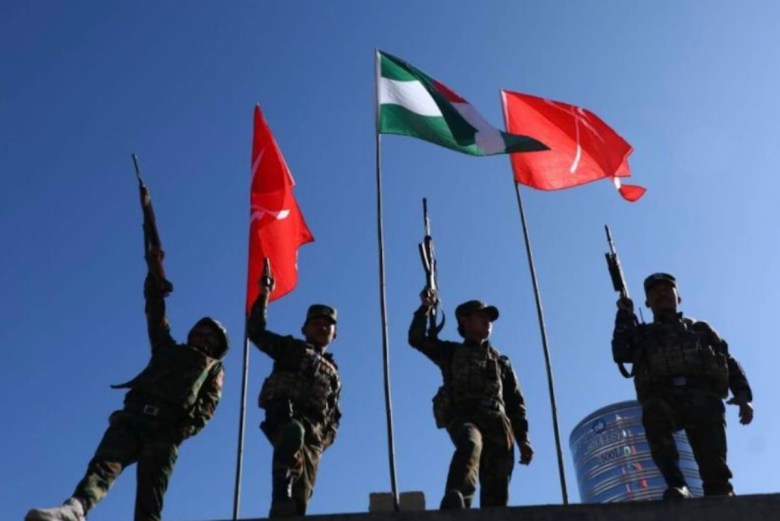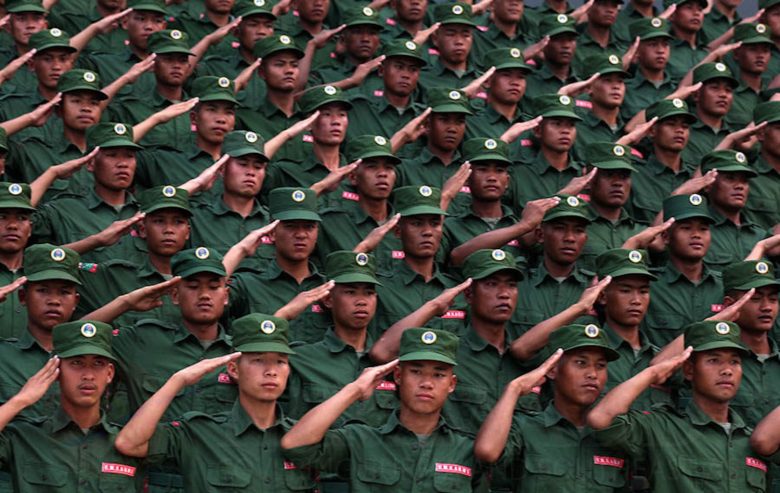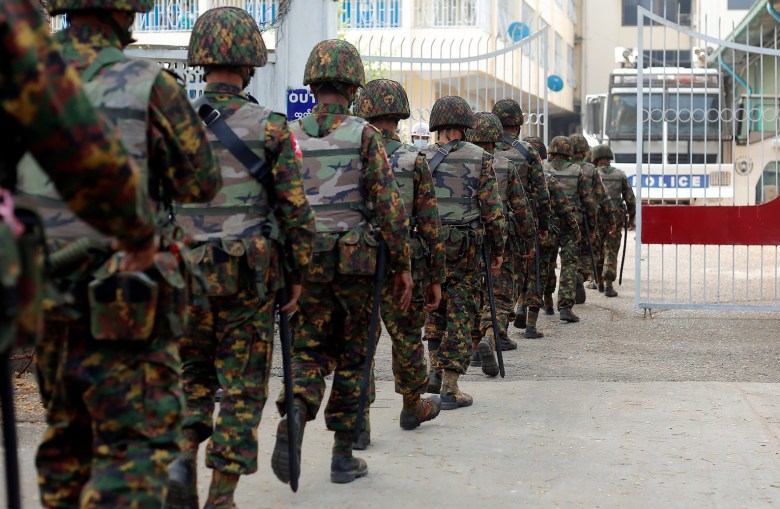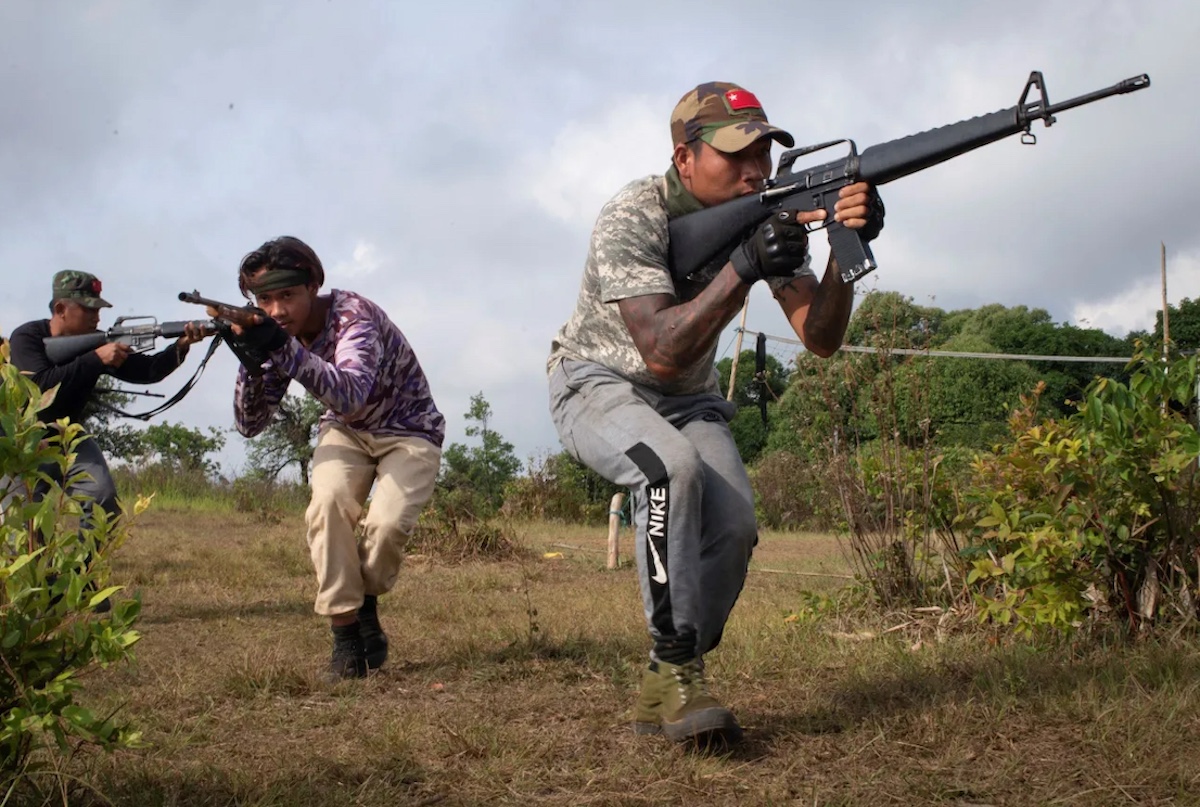In the closing weeks of 2023, the sweeping advances of an alliance of ethnic forces across Myanmar’s northeastern Shan state were often described as a watershed in a slow-grinding war, a telling sign that a military regime long held to be too big to fail could after all be defeated and ultimately overwhelmed.
Eight months on, following the late June collapse of a shaky Chinese-brokered ceasefire, a return to full-scale war and the military’s signal loss of the north Shan city of Lashio mean the issue looming over Myanmar is now of an entirely different order.
It turns simply on whether, beyond the watershed, the second phase of the 1027 campaign initiated by the Brotherhood alliance on October 27 last year has triggered a landslide of accelerating and potentially terminal reverses for the State Administration Council (SAC) coup regime; or whether, propped up by another Chinese-sponsored ceasefire, the military, or Tatmadaw, can stabilize an increasingly desperate situation.
In three fundamental respects, the latest hostilities in northern Myanmar have wrought a sea change in the conflict. Importantly, all three underscore the rapidity with which events are assuming a momentum of their own beyond the control of any of the main actors, domestic or external, but with striking geopolitical implications that will impact them all.
The decisive shift of hostilities into the national heartland spearheaded by ethnic Bamar People’s Defense Forces (PDFs), militarily capable and largely loyal to the opposition’s National Unity Government (NUG), has been the first and perhaps biggest game-changer.
Launched on June 25, 1027 Phase Two was planned and executed across three organizationally and logistically distinct fronts.
One, best described as the “highway front”, required seizing control of the towns of Nawnghkio, Kyaukme and Hsipaw strung out along the national highway between the regional capital of Lashio and Mandalay in central Myanmar.
That task has fallen mainly to the ethnic Palaung Ta’ang National Liberation Front (TNLA), a force of around 11,000 troops based in the tea-growing hill country in the northwest of the state.

Focused on Lashio itself, operations on the second front were undertaken by the TNLA’s Brotherhood ally, the Kokang Chinese Myanmar Nationalities Democratic Alliance Army (MNDAA).
A city with a pre-1027 population of some 200,000 and an army garrison estimated in late June at around 6,000 troops, Lashio constitutes the strategic lynchpin of northern Shan state and, until it finally fell on August 3, was the headquarters of the Tatmadaw’s Northeast Regional military command (RMC).
From late June through July, fighting on both Shan fronts was bitter as Brotherhood forces, hammered by unrelenting airstrikes, assaulted and overran a score of well-defended battalion bases screening all four urban centers.
By the beginning of August, the two Brotherhood allies had basically secured their key objectives, albeit at a high human cost. Neither side has even hinted at its losses, but given the scope and intensity of the fighting, it is probably safe to assume a toll of at least 5,000 killed and wounded on both sides.
The critical new element of 1027 Phase Two, however, has been a third western front driving into the national heartland along the Ayeyarwady Valley. Fighting in this zone spread from the ruby-mining center of Mogok south to the outskirts of the country’s second-largest city, Mandalay, with Bamar PDFs spearheading the advance.
The most notable has been the Mandalay PDF (MDY-PDF), a well-organized and well-equipped force of at least 3,000 troops based in the hills along the Shan state-Mandalay Region border to the north of the garrison town of Pyin Oo Lwin.
While the force has declared its allegiance to the NUG and received some funding from the shadow government, it has grown since late 2022 as the result of training and material support provided by the TNLA and operates under TNLA command and control.
As in Shan state, opposition advances were fiercely contested: joint TNLA and PDF forces did not finally secure Mogok until July 24. Further south, the strategically vital town of Singu where a bridge across the Ayeyarwady links northern Mandalay Region to Shwebo city in Sagaing Region, fell to PDF forces on July 20.
By that time PDFs were attacking army-held villages 20 kilometers from the northern suburbs of Mandalay which, with its population of 1.6 million, is the headquarters of the Central RMC.
The shift of large-scale hostilities into the Bamar heartland is critically significant. It offers logistical and organizational connectivity between the MDY-PDF and opposition forces in two other key zones: to the north, the riverine towns of Tigyaing and Katha that fall within the greater sphere of influence of the Kachin Independence Army (KIA); and to the west, the resistance hotbed of central Sagaing around Shwebo city, potentially threatening the highway between Shwebo and Mandalay.
If in the coming weeks the TNLA/MDY-PDF combine advances from newly captured Nawnghkio along the highway to threaten the garrison town of Pyin Oo Lwin, the noose around Myanmar’s ancient royal capital would tighten inexorably from both the north and east.
Limits of Chinese influence
While highlighting the role of well-organized PDFs with strategic punch, 10.27 Phase Two has also laid bare the stark limits of Chinese influence in stemming the coming landslide.
Following the collapse of the Hai Geng ceasefire, an agreement reached in Kunming in January this year, repeated efforts to broker another cessation of hostilities in the midst of fierce battles proved predictably unsuccessful.
All three Brothers – including the alliance’s third partner, the Arakan Army (AA) – benefit to a greater or lesser degree from cross-border connectivity with China and have been at pains to stress that they will safeguard Chinese economic and infrastructure interests.
At the same time, all three are evidently intent on prioritizing war objectives that go well beyond securing autonomy for their own regions to include supporting at various levels Bamar efforts to bring down the edifice of military dictatorship.
For its part, China is undoubtedly deeply frustrated with Senior General Senior General Min Aung Hlaing, a capricious and incompetent dictator whose 2021 coup effectively torpedoed Beijing’s long-term economic and geostrategic objectives in Myanmar.
At the same time, China has no interest in facilitating the collapse of the SAC regime, which it fears would mean either a descent into fragmentation and chaos or an interim administration in Naypyidaw centered on a NUG that Beijing views as a stalking horse for Western meddling in its backyard.
As a result, Beijing appears caught between the Scylla of the Brotherhood and aggressive PDFs it cannot rein in and the Charybdis of its support for a regime in Naypyidaw led by generals whose floundering defeats and potential collapse have set at risk years of economic and political investment in Myanmar.
Thrown into sudden relief by the fall of Lashio, the upshot will not be a foreign policy debacle on the scale of Cambodia 1978, when Beijing’s errant Khmer Rouge proteges were abruptly swept from power by a Vietnamese army forcing thousands of Chinese advisors to flee for their lives.
But the dilemma policymakers in Beijing are wrestling with today is already a far cry from the caricature of China-in-Myanmar projected by its many Western critics: as a deeply prescient chess master skillfully moving pawns and knights in pursuit of grand geostrategic ambitions stretching decades into the future.
All of that, however, has gone to underscore the importance of one trusty knight that China does have on the board and can probably count on: the United Wa State Army (UWSA), one of the world’s largest drug-trafficking militias.

The sudden intervention of the China-leaning, 30,000-strong force which had earlier stood aside from the post-coup chaos sweeping the rest of the country has undoubtedly been the third major game-changer triggered by 1027 Phase Two.
Having grown strong, rich and influential behind the shield of a 35-year-long ceasefire with the Tatmadaw, the once-despised Wa tribals have emerged from their mountain redoubts east of the Salween River and along the Thai border to reshape the political and military balance across south-central Shan state.
On July 27, even as fighting in Lasho still raged, a contingent of around 500 Wa troops advanced into the city as a neutral force enjoying good relations with both belligerents ostensibly to protect a liaison office and other real estate interests.
Not lost on independent observers, however, was that the UWSA had effectively taken advantage of the conflict to establish a significant and easily reinforceable military presence in the regional capital of north Shan well beyond their traditional bailiwicks.
For those paying attention, pointers to the wider scope of Wa ambitions had come 16 days earlier in central Shan State when on July 11 UWSA forces abruptly crossed the Salween River and occupied the Tatmadaw garrison town of Tangyan on the west bank without a shot fired.
It remains unclear whether the move was brokered by China two days earlier when Myanmar Army commander Vice Senior General Soe Win was attending a Shanghai Cooperation Organization meeting in the Chinese city of Qingdao — and likely pleading with his hosts to rein in the Brotherhood and pass on more ammunition.
But the occupation of Tangyan was clearly agreed in advance with the Tatmadaw garrison and effectively shielded the army from losing the town to advancing MNDAA and TNLA forces.
It was also coordinated with a close Wa protege, the ethnic Shan State Progress Party (SSPP) which since the coup has benefitted from new infusions of UWSA-supplied weaponry, vehicles and drones to expand its presence west of the Salween. Shortly after the Wa moved into Tangyan, SSPP troops advanced into Mong Yai town 65 kilometers to the west that controls the road to Lashio.
The Wa power-play has served to throw into sharp relief two new realities with major geopolitical implications. The first is that the UWSA-SSPP alliance is now well-placed to dominate south-central Shan state.
The expansion will come at the cost of the only other significant ethnic faction in the region: the SSPP’s longtime rival for leadership of the state’s ethnic Shan majority, the Restoration Council of Shan State (RCSS).
Led by Yord Serk, an aging warlord-cum-businessman, and already weakened by a string of military reverses, the RCSS faces the imminent prospect of being pushed back to its bases on the Thai border.
Its retreat would leave the Wa-SSPP combine dominant across the entirety of central and southern Shan state sharing a loose border with the northern Brotherhood Alliance forces of the MNDAA and TNLA.
The second emerging reality is closely related to the first: the Tangyan gambit served to lay bare the striking weakness of the Myanmar military, an incapacity with potentially far-reaching repercussions.

As the Tatmadaw faces escalating pressure in the national heartland in the coming months, the Tangyan precedent is all too likely to encourage further Wa takeovers of larger army bases in eastern Shan state, including potentially the Triangle RMC in Keng Tung and Tachilek city, a short drive south on the Thai border.
Any such scenario implies the realization of a long-cherished Wa dream: the merger of the UWSA’s autonomous zone along the China border with its Military Region 171 enclave on the Thai border.
The territorial tie-up would mean the emergence of a newly unified “Wa State” with close political, military and economic links to China and sympathetic to China’s infrastructure ambitions in Shan state and beyond.
What for the Wa leadership is a dream on the cusp of reality, however, may prove a nightmare for Thai military planners already struggling to stem a tsunami of illicit narcotics flowing south across a porous border from industrial-scale production centers in Wa-ruled territory.



How often over the last two decades have we read articles about Myanmar collapsing.
Wishful thinking is the core of all these articles. When do the anti junta writers accept facts?
Ha! That’s the kind of thinking that considered the junta ‘too big to fail’, and now look – it controls only 1/3 of the country and is losing more every day. The regime’s days are clearly numbered.